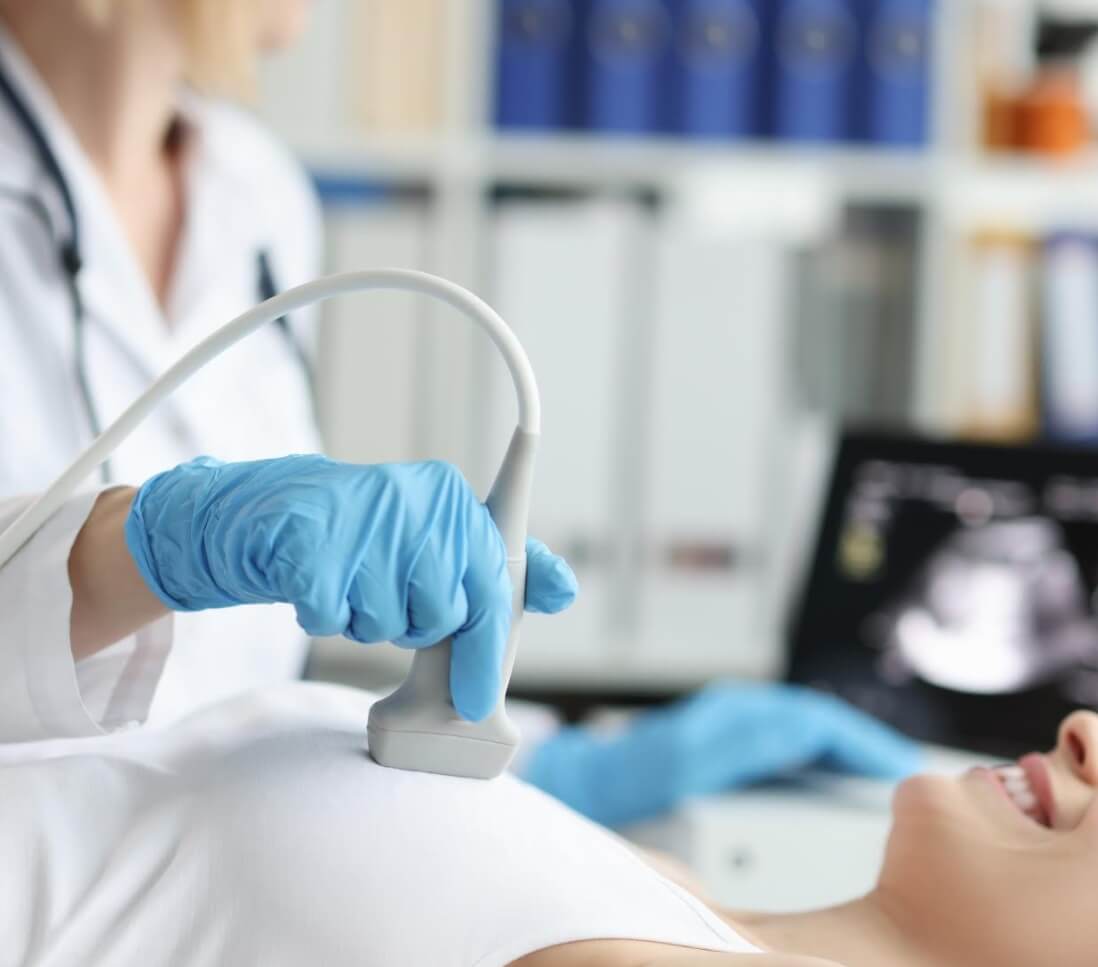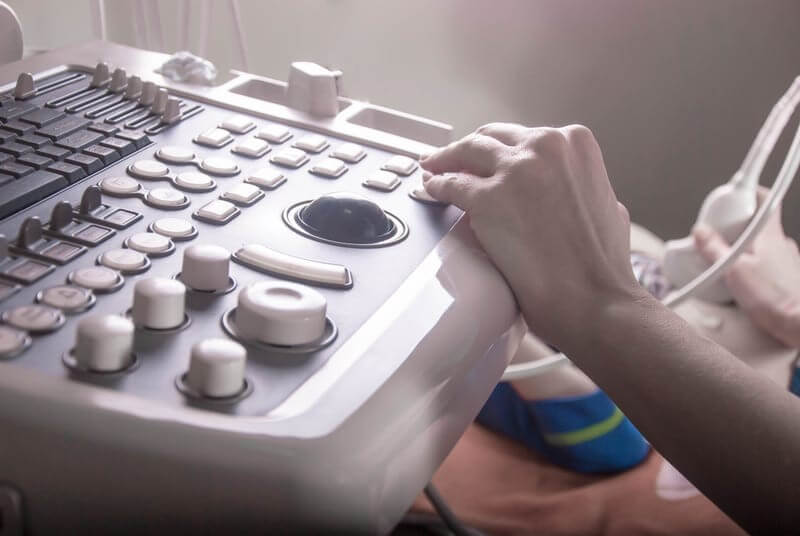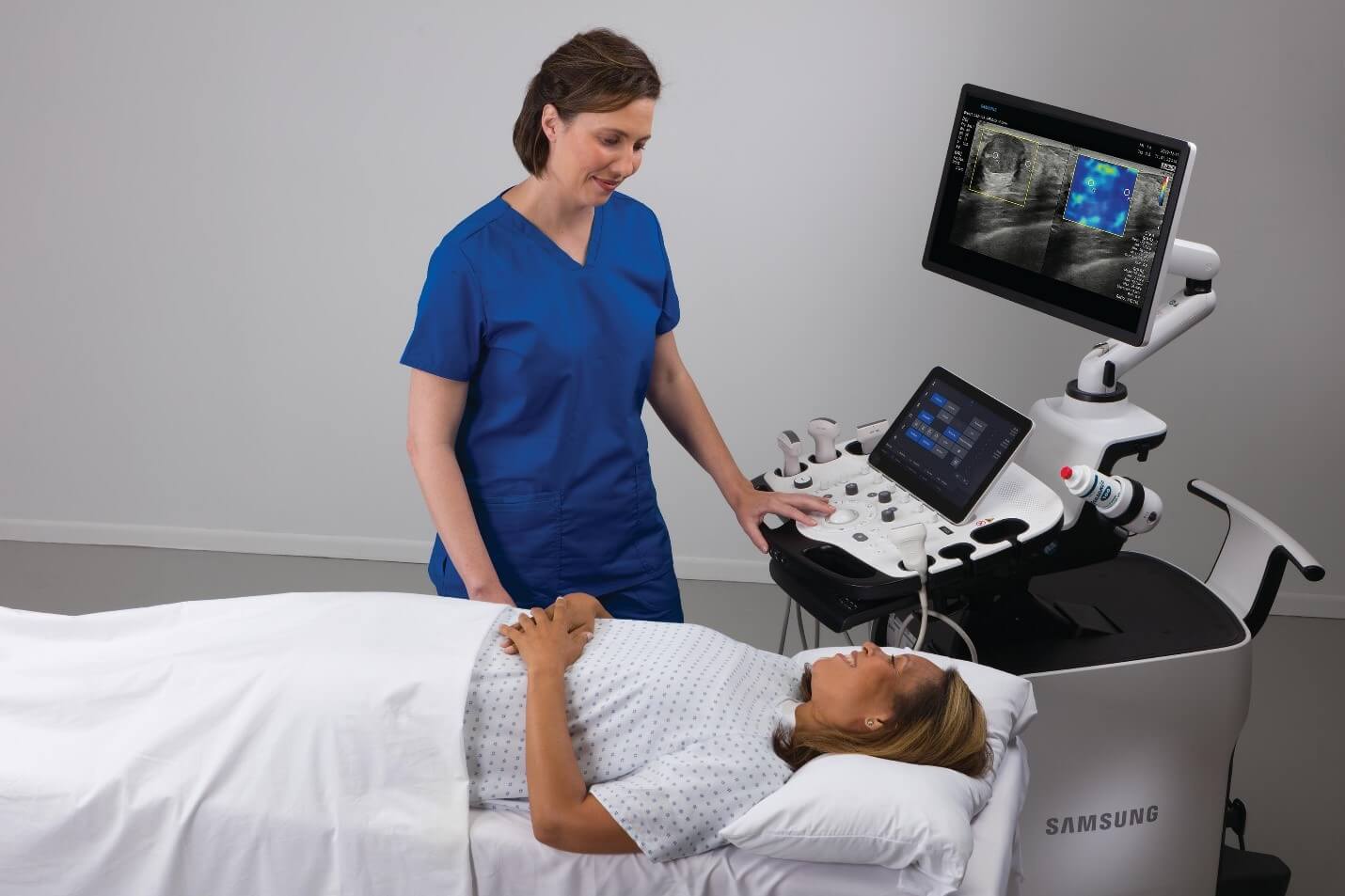Breast ultrasound or breast ultrasound
Ultrasound imaging of the breast uses sound waves to produce images of the inner structures of the breast. It is used to help diagnose breast lumps or other abnormalities found during physical examination, either in mammography or breast MRI. Ultrasound is safe and non-invasive and does not use radiation.
Breast ultrasound scans do not require special preparation. Preferably leave your jewellery and ornamental objects at home and wear loose and comfortable clothes.
What is Breast Ultrasound Imaging?
Ultrasound imaging is a non-invasive medical scan that helps doctors diagnose and treat. This imaging is safe and painless. Using sound waves, it produces images from inside the body. The imaging uses a small probe called a transducer and gel that is placed directly on the skin. High-frequency sound waves are transmitted from the probe and through ultrasound gels to the body. The ionography probe collects sounds that return. A computer uses those sound waves to create an image. X-rays are not used in ultrasound examinations. Since ultrasound, or ultrasound, takes images in real time, it can show the structure and movement of the internal organs of the body. These images can also show blood flow in blood vessels.
Doppler ultrasound is a special ultrasound technique that evaluates the movement of materials in the body. This scan allows the doctor to see and evaluate blood flow through the arteries and veins in the body.
Breast ultrasound creates a picture of the inner structures of the breast. During breast ultrasound examination, your doctor may use Doppler techniques to assess blood flow or lack of flow in any breast mass. In some cases, this practice may provide more information about the cause of mass emergence.

What are the common uses of breast ultrasound?
• Determining the nature of breast abnormalities
Doctors use breast ultrasound to help diagnose breast abnormalities that are detected during physical examination. The examination may include a lump or nipple discharge. They also use ultrasound to pinpoint potential abnormalities observed in mammography or magnetic breast resonance imaging (MRI).
Breast ultrasound can help determine whether a solid malformation (which may be a non-cancerous mass of tissue or a cancerous tumor), filled with fluid (such as a benign cyst) or cystic one.
• Complementary breast cancer screening
Mammography is the only breast cancer screening tool that reduces breast cancer deaths through early detection. However, mammography does not detect all breast cancers. Some breast lesions and abnormalities are not visible or are difficult to interpret in mammography. In breasts that are dense – meaning there are many ducts, glands, and fibrous tissue and less fat – many cancers can be hard to see in mammography.
Many studies have shown that breast ultrasound and MRI can complement mammography by identifying cancers that may not be visible with mammography. Breast ultrasound screening may identify abnormalities that are not visible with mammography, including those that may require a biopsy. Many of the abnormalities found in breast screening ultrasound are not cancer (false positives). MRI is more accurate at showing breast cancer than ultrasound, but an MRI may not be available to all women. If you receive MRI screening, ultrasound screening is not necessary.
Breast ultrasound can be used as a screening tool for women with the following conditions:
- Women who are at risk of developing breast cancer and are unable to undergo an MRI test.
- Pregnant women who should not be exposed to X-rays (which is essential for mammography).
- Women with dense breast tissue – when breasts have a lot of glandular and connective tissue and a lot of adipose tissue
Ultrasound-guided breast biopsy or biopsy
When breast ultrasound shows a suspected abnormality, the radiologist may prescribe an ultrasound-guided biopsy. Since ultrasound presents images in real time, doctors often use it to guide biopsy procedures. Breast ultrasound examination is usually necessary before a biopsy to plan the procedure and determine if it can be used.
How to prepare for breast ultrasound scans
You only need to wear a comfortable dress and you will often be given a gawn at the ultrasound imaging centres.
What is the appearance of an ultrasound device?
Ultrasound devices are composed of a computer console, monitor and a transducer attached to the device called an ultrasound probe. The probe is a small handheld device that resembles a microphone. Some scans may use different transducers (with different capabilities) during a scan. The probe sends inaudible, high-frequency sound waves into the body and listens to recursive echoes.

The technician examines a small amount of gel on the area and places the transducer there. This ultrasound gel allows sound waves to sweep between the transducer and the examined area. The ultrasound image is immediately visible on the monitor of the device. The computer creates the image based on the loudness (amplitude), step (frequency) and when it takes for the ultrasound signal to return to the converter. It also considers what kind of structure or texture the sound passes through.
What is breast ultrasound?
Ultrasound imaging uses the same sonar principles that bats, ships and fishermen use. When an audio wave hits an object, it bounces back or gives echoes. By measuring these echo waves, the distance of the object as well as its size, shape and consistency can be determined.
Doctors use ultrasound to detect apparent changes in organs, tissues and vessels, and to detect abnormal masses such as tumors.
In an ultrasound examination, a transducer sends both sound waves and echoes (return) waves. When the transducer is pressed on the skin, it sends small pulses of inaudible, high-frequency sound waves to the body. As sound waves are reflected from the internal organs, fluids and tissues, the sensitive receptor in the transducer records small changes in the modulation and direction of the sound. A computer immediately measures these waves and displays them as real-time images on the monitor. The technician usually takes one or more frames of motion pictures as still images. They may also save short videos of the scan.

Doppler ultrasound, a special ultrasound technique, measures the direction and speed of blood cells as they move through the vessels. The movement of blood cells causes changes in the modulation of reflected sound waves (called the Doppler effect). A computer collects and processes sounds and creates color diagrams or images that show blood flow in blood vessels.
For breast ultrasound, you first lie on the bed of the device on your back or sideways. Your doctor may ask you to put your hands above your head.
The radiologist or the same doctor will place your ultrasound on the examination bed. They apply a water-based gel in the area under body examination. The gel helps the probe to make safe contact with the body. It also eliminates air holes between the transducer and the skin that can prevent sound waves from passing into your body. The doctor places the transducer on the chest and moves it back and forth in the desired area until it takes the desired images.
There is usually no pain or pressure as they gently place the transducer on the examined area. However, if the area is sensitive, you may feel pressure or minor pain from the transducer. Doctors perform Doppler ultrasound with the same transducer.
Once the imaging is complete, the technician will remove the transparent ultrasound gel from your skin. Any part that remains will dry quickly. Ultrasound gel usually does not stain or discolor the garment.
What will you experience during and after breast ultrasound?
Most ultrasound examinations are painless, fast and easily tolerable. Breast ultrasound is usually completed within 30 minutes. If your doctor performs a Doppler ultrasound examination, you may hear pulse-like sounds that change by monitoring and measuring blood flow. You may need to change position during the scan. When the examination is complete, the technician may ask you to get dressed and wait for the ultrasound images to be checked. After an ultrasound examination, you should be able to resume normal activities immediately.
Who interprets the scan results and how can you get them?
A radiologist, a doctor trained to monitor and interpret radiology examinations, will analyze the images. The radiologist sends a signed report to the doctor who requested an examination. Your doctor will then share the results with you. In some cases, the radiologist may share the results with you after the examination.
In some cases, you may need a further examination. If so, the doctor will explain why. Sometimes a re-scan assesses a potential problem with more hits or a specific imaging technique. It is also possible to see if there has been a change in a topic over time. Subsequent examinations are often the best way to see if the treatment has been effective.
What are the benefits of breast ultrasound scans against its risks?
Benefits
- Most ultrasound scans are noninvasive (no needles or injections).
- Sometimes, an ultrasound examination may be temporarily uncomfortable, but it shouldn’t be painful.
- Ultrasound is widely available, easy to use and cheaper than other imaging methods.
- Ultrasound imaging is very safe and does not use radiation.
- Ultrasound scans provide a clear picture of soft tissues that are not well represented in X-ray images.
- Ultrasound offers real-time imaging. This makes it a good tool to guide low-invasive procedures such as needle biopsy and fluid aspiration.
- Ultrasound imaging can help detect lesions in women with dense breasts.
- Ultrasound may help to diagnose and classify a breast lesion that cannot be interpreted by mammography alone.
- Using breast ultrasound, doctors can determine that many areas of clinical concern are due to normal tissue (such as fat lobules) or benign cysts. For most women 30 years and older, mammography is used along with ultrasound. For women under the age of 30, ultrasound alone is enough to determine whether the area needs a biopsy.
Risks
- Standard diagnostic ultrasound has no known harmful effects on humans.
- Interpretation of breast ultrasound examination may lead to additional measures such as subsequent ultrasound and/or aspiration or biopsy. Many areas believed to be worriscent are non-cancerous (false positives).
What are the limitations of breast ultrasound imaging?
- Ultrasound is one of the tools used in breast imaging, but it does not replace annual mammography.
- Many cancers are not visible in ultrasound. Many of the calcifications seen in mammography are not visible in ultrasound. Some early breast cancers only appear as calcification in mammography. MRI findings due to cancer are not always seen with ultrasound.
- A biopsy may be recommended to determine whether a suspected malformation is cancerous or not.
- Most suspected findings in ultrasound requiring biopsies are not cancer.
- Many do not offer ultrasound screening facilities even in women with dense breasts, and this method may not be covered by some insurance plans.
Final word:
The scientific and specialized medical scanning team hopes to use this article on breast ultrasound and answer frequently asked questions that may come to your mind. Ultimately it is important to choose a center with expertise in breast ultrasound, preferably where radiologists specialize in breast imaging. Ultrasound depends on the diagnosis of anomalies at the time of the scan because it is a “real-time” examination. You can confidently and easily receive
breast ultrasound
through the Scan Teb website at www.scanteb.com address throughout the country. If you have any questions, we are ready to provide you with the necessary guidance.








افزودن دیدگاه